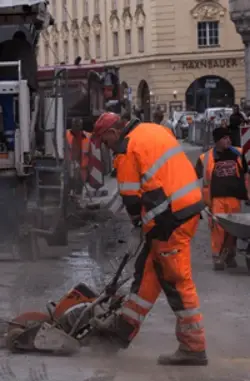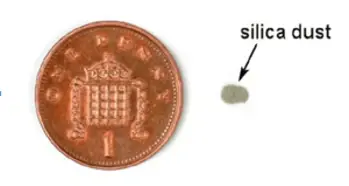Calculating Time Weighted Average:
As per the HSE, ”The term ‘8-hour reference period’ relates to the procedure whereby the occupational exposures in any 24 hours are treated as equivalent to a single uniform exposure for 8 hours (the 8-hour time-weighted average (TWA) exposure).” EH40/2005 Workplace exposure limits Page 34.
The following formula is used to calculate the time-weighted average:
= duration x average concentration ÷ 8
Example: Where a site worker on an 8-hour shift is exposed to a substance during that period at a level of 25mg/m3, the time-weighted average would be calculated as:
(8x25)/8 = 25mg/m3
Is RCS considered a carcinogen?
The International Agency for Research classifies RCS as a Category 1 Carcinogen. A carcinogen is any substance that causes cancer in humans. A Category 1 carcinogen is known to cause cancer in humans.
I wear a mask. Am I safe from RCS?
No, respirable crystalline silica is too fine to be stopped by a normal mask alone. Even with water suppression, the HSE recommends using a face mask with a protection factor of 20. For further guidance on AFP 20, please check the HSE COSHH Essential: Respiratory protective equipment (RPE) - R3 document. An assigned protection factor of 20 or APF 20 means that you only breathe in 1/20 of the dust in the air. Construction dust CIS36
What not to do when cleaning up RCS
Dry sweep – use vacuum or wet cleaning
Use compressed air to remove dust from clothing.
Is Silicosis treatable?
There is no known cure for silicosis. Prevention is the only way to protect yourself from the disease. Once silicosis has developed, the doctors will “manage” the disease.
The Symptoms of Silicosis
The main symptoms of silicosis:
Persistent cough
Shortness of breath, especially during physical activity
Chest pain or discomfort
Fatigue and weakness
Weight loss in advanced cases
Increased susceptibility to lung infections
Early identification of these symptoms is important for maintaining health and safety standards.
When to See Your Doctor
Regular health check-ups are recommended if you work in an industry that has exposure to RCS. Generally, if you have a breathing difficulty that does not improve over a period of time, then you should get checked by a doctor.
Employers are required by law to:
The employer is obliged by law to carry out a risk assessment for the work activities. The risk assessment is carried out to identify the controls and measures by which exposure could lead to higher levels than dictated as safe. Employers must abide by the Control of Substances Hazardous to Health Regulations 2002 (COSHH) and need to:
Keep written records of any risk assessment. This applies to employers that have more than five workers.
Disclose any pertinent details found in the risk assessment.
Try to prevent and control exposures to RCS.
Provide proper PPE where necessary.
Provide adequate instruction and training on the safe use of equipment.
Ensure that the WEL for RCS is not exceeded through monitoring and implementing controls.
Commodious offers an advanced level 2 online Advanced COSHH Training Course specifically designed for employers, managers and supervisors with responsibility for the welfare of employees and the management and control of substances hazardous to health. Commodious also now provides a specific 'Dust Awareness Training Course'.
Employee Responsibilities
Employees, whether full-time or part-time, have a legal duty to ensure their health and safety while at work.
You should always:
Ensure your safety and the safety of those around you.
Ask how to execute the job that you are assigned safely.
Ask if the work you are doing involves the risk of being exposed to RCS.
Conclusion
RCS is a major health threat, but with correct training, monitoring, and COSHH-compliant control measures, it can be effectively managed. Protecting workers from silica dust is essential for preventing permanent respiratory damage and maintaining a safe workplace.
For more support, you can read our Dust at Work Topic, check our Dust at Work FAQ, or explore our dust control measures guide for practical steps on reducing exposure.



